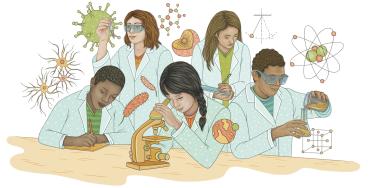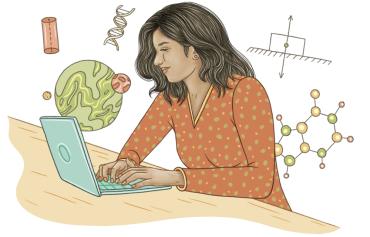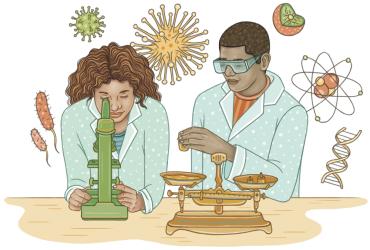What does it mean to be a scientist? In the most basic of terms, a scientist is someone who does scientific research. But what personal qualities does it take to do scientific research?
In his book Letters to a Young Scientist, renowned biologist Edward O. Wilson recounts his own coming-of-age story as a scientist, and distills the motivating qualities of science down to curiosity and creativity. Individuals become scientists when they are curious about a phenomenon in the world around them and ask about the real nature of that phenomenon: What are its origins, its causes, or its consequences? Scientists then employ some creativity to answer their questions through a systematic testing of hypotheses (the scientific method), and form some conclusion based on their findings.
This explanation of how scientists approach research highlights something very powerful: anybody with curiosity and creativity, by subscribing to the scientific method, can do science and discover something new about our natural world. From an early age, children brim with questions and sometimes come up with overly creative methods to test a hypothesis (say, using a magnifying glass to start a fire). It becomes incumbent upon teachers, then, to continually help foster students’ curiosity and creativity as critical aspects of their learning, particularly in science.
Wilson describes the broad field of science as a “culture of illuminations dedicated to the most effective way ever conceived of acquiring factual knowledge.” His description points to another critical aspect in becoming a scientist: not only acquiring some knowledge but contributing that knowledge to a shared culture and community. Scientists engage with others in their field through collaborations, presentations, and publication, thereby strengthening their own findings and assessing information within a broader context of knowledge. While public school students should receive more resources and guidance to do science in schools, motivated students have typically had very limited avenues to experience being a scientist—that is, by sharing their research with the larger scientific community.
The Journal of Emerging Investigators (JEI) was established to address this challenge. A nonprofit online science publication exclusively for middle and high school students, JEI gives students an opportunity to submit original research, receive feedback on their work from expert scientists, and have their work published. Through this process, students grow their scientific knowledge and skills, helping them become the next generation of scientists.
One such student is Suvir Mirchandani. As a sixth-grader at Dorseyville Middle School in Pittsburgh, Mirchandani was curious whether he could reduce the amount of ink used to print handouts at his school. To test his hypothesis that changing the font could decrease the amount of ink used, he had a clever idea. He first calculated the five most frequent letters used in teachers’ handouts, and he printed enlarged copies of these letters onto heavy cardstock in four different fonts: Century Gothic, Comic Sans MS, Garamond, and Times New Roman. He cut out the letters, compared the masses of each font type, and found that Garamond was the winner.
Mirchandani calculated that his school could save 13 to 24 percent on ink costs, or nearly $24,000 for the school district, by switching from Times New Roman to Garamond 12-point font. After presenting his project at a science fair, Mirchandani’s teacher encouraged him to submit a manuscript to JEI. Impressed with his results, JEI accepted and published his manuscript in 2013.
JEI editors suggested Mirchandani apply his experiment to a much larger scale of printing than his school: the entire U.S. government. Redoing his experiment with a sample of publicly available documents from federal agencies, he found that by switching to Garamond in federal documents, the government could save, on average, an astounding $234 million in printing costs. JEI published these results in 2014.
Mirchandani’s publications garnered attention from major news outlets like CNN, giving him a greater platform to share his ideas. While it’s not clear if the government will indeed follow Mirchandani’s advice and transition to a more ink-efficient font, what is certain is that even young investigators, thanks to the support of fellow scientists and the opportunity to publish, can meaningfully contribute to society.
Beyond the Science Fair
Sarah Fankhauser founded the Journal of Emerging Investigators in 2011 during her early years of pursuing doctoral work in microbiology at Harvard Medical School. By volunteering at science fairs, afterschool science programs, and other K–12 outreach programs, she saw that middle and high school students were capable of conducting independent and creative research.
While students were often very proud of their projects and excited to show them at science fairs, there were often no avenues for students to continue discussing their results or expand on their projects after the fairs. Moreover, anyone who did not attend that particular science fair would miss out on the research students had done. So Fankhauser considered how experienced scientists share their work with the public—through peer-reviewed publication.
It may sound daunting for young students to publish their work, but Fankhauser found evidence they could do it. That year, a class of third-grade students published their original research on bumblebee foraging behavior in Biology Letters, a journal of the Royal Society publishing group.* The experiments were designed, carried out, and summarized by 25 8- to 10-year-olds in Devon, England, under the supervision of a teacher and a research scientist. Their research is compelling because it gave new insight into color and pattern recognition of the bee. As the authors put it, “No one in history (including adults) has done this experiment before.” And it demonstrated that with support from a teacher, even very young students are capable of communicating their research like scientists do.
Beyond that single article, though, Fankhauser could find no science publications for K–12 students that met two criteria she considered basic for a peer-reviewed publication for middle and high school students: it had to be free for students to submit their manuscript, and it had to include an educational aspect through the course of publication. For scientists, that educational aspect comes from scientific review, where peer scientists read manuscripts and offer feedback on the scientific quality and presentation of research. The scientific review process helps scientists understand the strengths and weaknesses of their papers and improve their experiments. Peer review is a key aspect of communication in science that students would never experience before committing to a university-level track in research.
So Fankhauser, now an assistant professor of biology at Emory University, approached a handful of her fellow graduate students with the idea of creating a free way for middle and high school students to publish scientific research and experience the peer review process. They responded enthusiastically, and together they founded JEI.
Since 2011, JEI has received more than 300 submissions from students across the United States and 14 submissions internationally. It has published more than 100 articles on original research in the physical and social sciences. While high school students author the majority of articles, middle school students, like Mirchandani, author about a 10th of JEI publications. In addition to science fair projects, students submit manuscripts about original research they conducted during a summer research internship or at home under the guidance of a parent. As JEI has grown, more teachers have encouraged groups of students to design and conduct experiments in a classroom setting and submit their research to JEI.
Articles adhere to the usual format of a scientific paper: each begins with an introduction to the scientific inquiry and the student’s hypothesis. The author then describes the experiment he or she conducted to test the hypothesis and explains the method and results. Finally, the student discusses the implications and potential weaknesses of his or her study. Some students may be familiar with the layout of a primary scientific article, but for many, this is their first experience in communicating science as a scientist would. As a result, the JEI experience helps students think critically about their work and prepares them for reading and writing college-level scientific papers.
While biology papers predominate in JEI publications, the range of topics students cover in their research is staggering. In JEI’s first article, published in 2012, high school student Sarah Geil asked whether the order in which you are born into a family affects your academic success. A pair of sisters in middle school asked which brand of diapers is really the most absorbent—Huggies or Pampers? Students have tested the antimicrobial efficacy of natural supplements like honey and ginger, and whether yogurt containing active cultures affects the growth of a bacteria found in the gut. A sociology study by one high school student investigated how older adults engage during technology training programs. Another high school student, interested in biomimicry, wondered if helicopter blades designed with whale-like tubercles would fly more efficiently.†
Every study begins with a student who is curious about a phenomenon, finds a way to investigate it, and works with a mentor to guide him or her throughout the research and the JEI review process. Generally, a teacher, professor, or parent acts as the student’s mentor, and becomes the senior coauthor on the final publication.
The Peer Review and Publication Process
Once students and their mentors submit drafts, the JEI editorial team manages their manuscripts through the peer review and publication process. The team began with two editors-in-chief, Lincoln Pasquina and Chris Wells, overseeing four editors, including Fankhauser. “We had tremendous support from the Division of Medical Sciences [at Harvard],” she says, “specifically David Cardozo,” associate dean for graduate studies and faculty adviser on the board of JEI. “He was a cheerleader from the very beginning.” The graduate student editorial team has since blossomed to nearly 60 reviewers, a dozen copyeditors, and three editors-in-chief.
I served as an editor with JEI for three years, and I’m now a co-editor-in-chief with Jamilla Akhund-Zade and Michael Marquis. As editors-in-chief, we are the first ones on the editorial team to read a student’s manuscript. We check that it has the appropriate structure of a science paper, that the student has clearly explained his or her research question, and that he or she has conducted the experiments to test the hypothesis. The editors also read the manuscript and decide if the student has presented original research that scientific reviewers can understand and comment on. If the manuscript meets these criteria, it is then assigned to a pair of reviewers.
The scientists who serve as JEI reviewers are graduate students, postdoctoral fellows, teachers, professors, and other researchers from across the country. After reading a manuscript, reviewers give feedback on the scientific content and writing style. A reviewer may point out a necessary control experiment the student must do to corroborate his or her findings, or suggest a fun additional experiment to try. As early-career scientists with graduate research experience, reviewers have years of research ideas and knowledge of their field to offer to younger scientists.
Student authors often express how thankful they are for the feedback. “I learned a lot from this process about science,” says one student, “and I appreciate the chance to publish!” The primary goal of the editorial team is to accept as many manuscripts for review as possible, so that the students receive educational feedback from scientific reviewers about their work, even if students ultimately decide not to pursue their projects to publication.
Except in serious cases like plagiarism, we accept every submission, pending scientific or written revisions by the authors. The editorial team consolidates the reviewers’ feedback into a one-page summary letter to the authors, followed by several pages of line-by-line comments from reviewers. Receiving this critique of their work can be disheartening for students, so we always note the strengths in students’ work and not only where they need to improve.‡
In our scientific review, we try to help students clearly communicate a testable hypothesis that they generate from previous knowledge, data, and observations. We encourage students to search for scientific literature on their topic of interest to learn what other scientists have done and to gain an understanding of how others present and discuss their research. While their hypothesis does not have to be completely novel, we do expect that it is novel to the students; through their experiments, students must have learned something new. We also seek to offer students some guidance on how to perform their experiments and how to analyze their data to attain meaningful answers to their inquiry.
Finally, we help students combine their own data with their background knowledge to deeply discuss the results of their experiment. This final aspect tends to be the most difficult for students, because of the way in which students typically learn science. Both in school and in popular culture, the results of experiments are often explained as proving a certain hypothesis as right or wrong. But this approach leads students to believe there is finality in scientific inquiry, which is not true in reality. Through the editorial process, we try to show students that doing research is not about being right or wrong in the end. Instead, we encourage them to see their research as a single contribution to a much grander scale of scientific inquiry—with always more questions to explore.
After receiving their letter from the editorial team, students can revise their manuscript and conduct any additional experiments that have been suggested. We try to be realistic about how much time and resources students may have to carry out more experiments, so they won’t be discouraged from continuing to work on their project. They then submit their revised manuscript to JEI.
All manuscripts require at least one round of revision and resubmission—a markedly different experience for students than presenting their research at a science fair. Once the editorial team is satisfied with the improvements, the accepted manuscript moves on to copyeditors, who proofread the manuscript and help the authors improve the clarity of their writing. Finally, editors generate a proof of the article, review it one final time, and publish it on the JEI website. After so much hard work, the authors and the editorial team are thrilled to see the final product.
Working with JEI is a rewarding opportunity not only for the student authors but also for the graduate students who comprise the editorial team. It has enabled us to learn about a variety of topics beyond our specific fields, and the opportunity to edit the work of younger peers has allowed us to improve our own science communication skills.
Typically, graduate students do not get a chance to review research articles; we only experience the process of review and revision a handful of times when submitting our own research for publication. This is a shame, since scientific review is a prime way to discuss our research with others outside of our personal sphere.
In the next few years, we at JEI hope to expand our reach to more students and teachers and to grow our editorial team. We hope that by submitting manuscripts to JEI, students come to understand that any question a scientist is deeply curious about is worth investigating, and that we, as fellow scientists, look forward to reading their work and guiding them.
Olivia Ho-Shing is a graduate student in neurobiology at Harvard University and a co-editor-in-chief of the Journal of Emerging Investigators.
*P. S. Blackawton, S. Airzee, A. Allen, et al., “Blackawton Bees,” Biology Letters 7 (2011): 168–172. (back to the article)
†These articles, and many others, can be found at the JEI website. (back to the article)
‡For more on the value of teaching effort and persistence in science, see “Stories of Struggle” in the Spring 2017 issue of American Educator. (back to the article)



